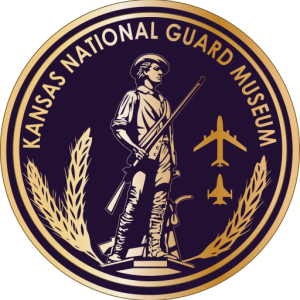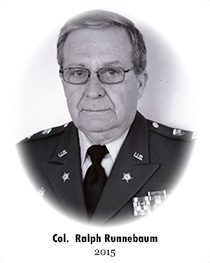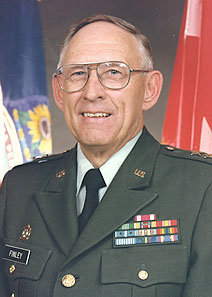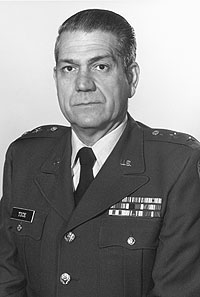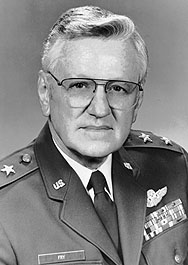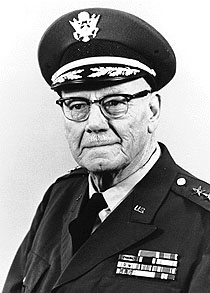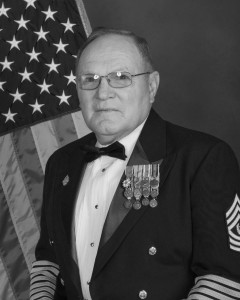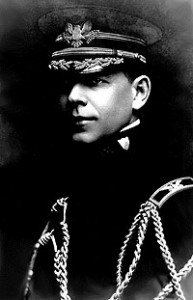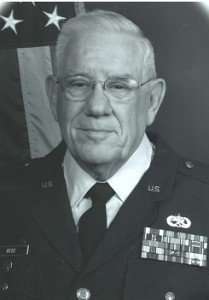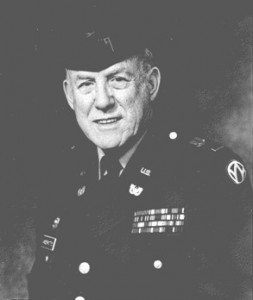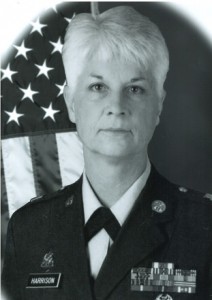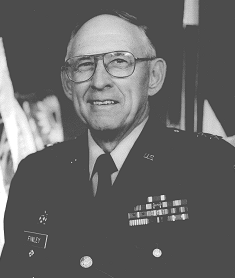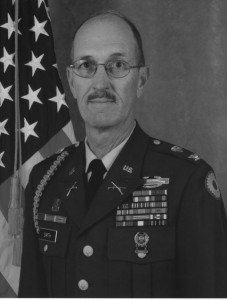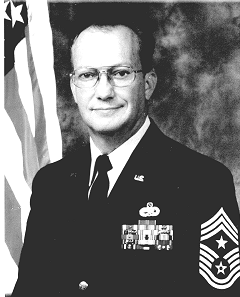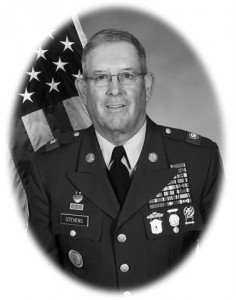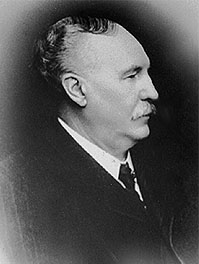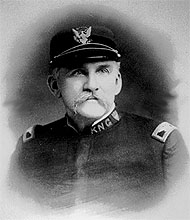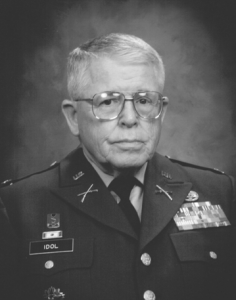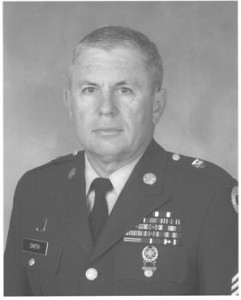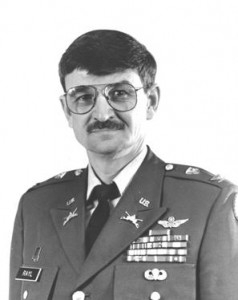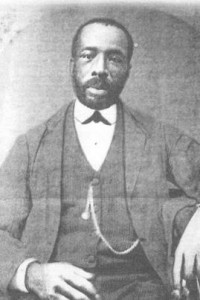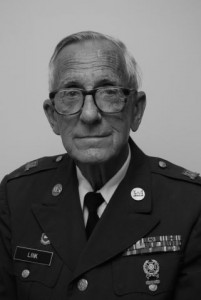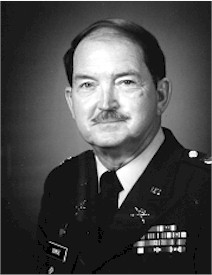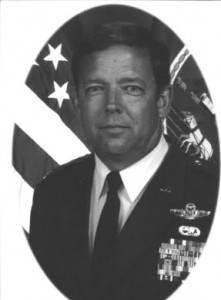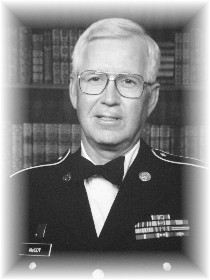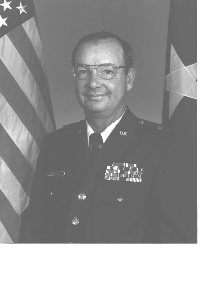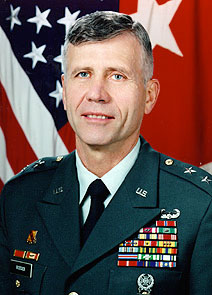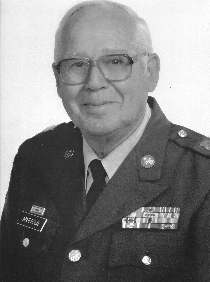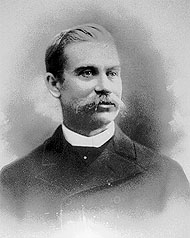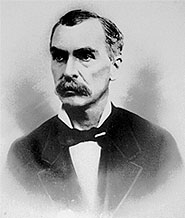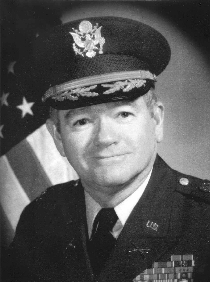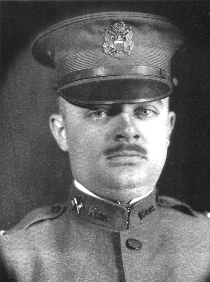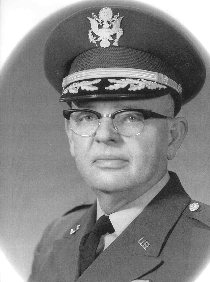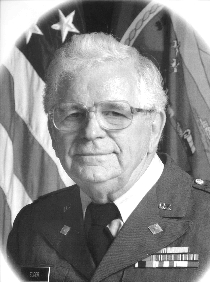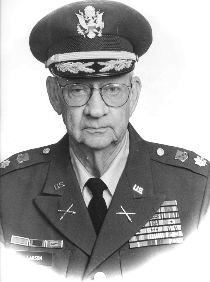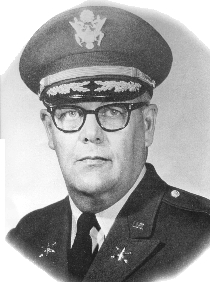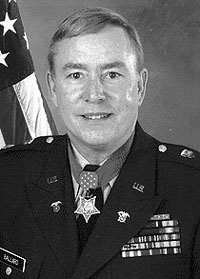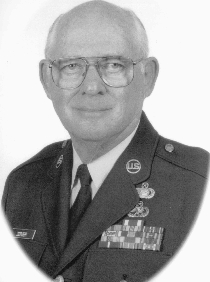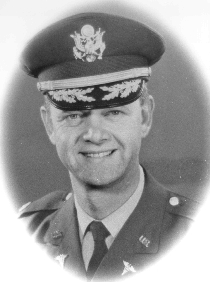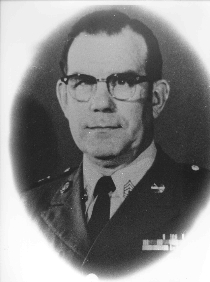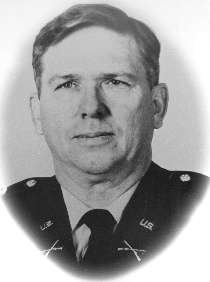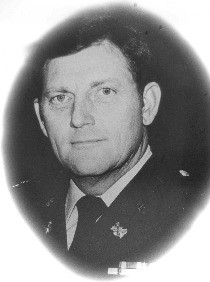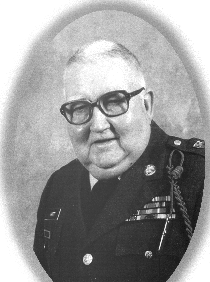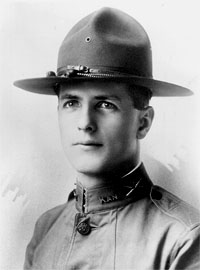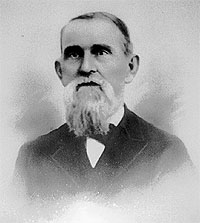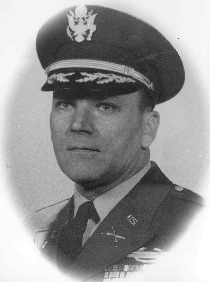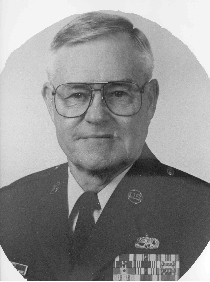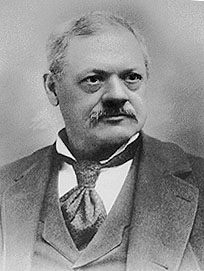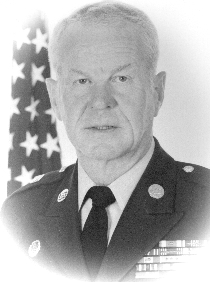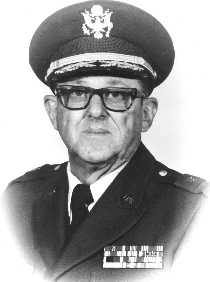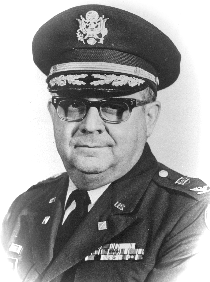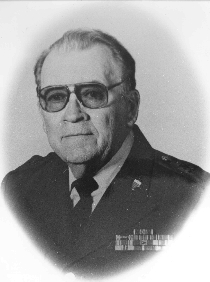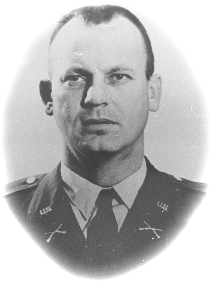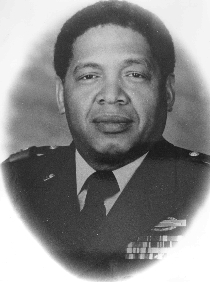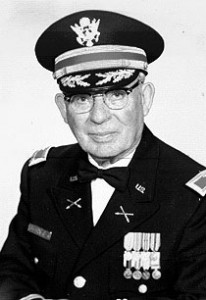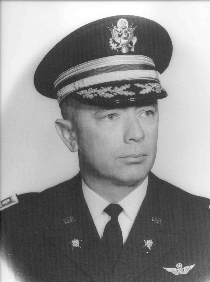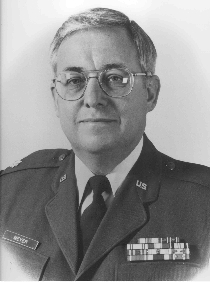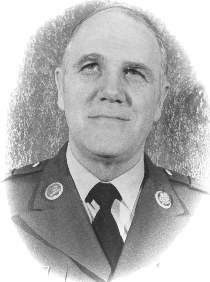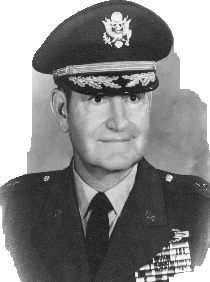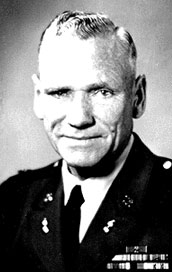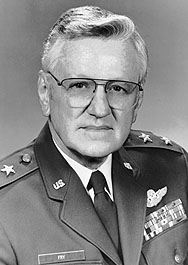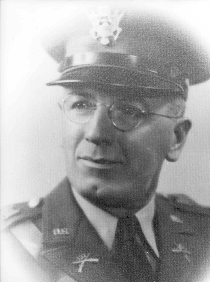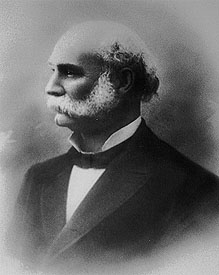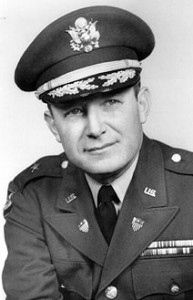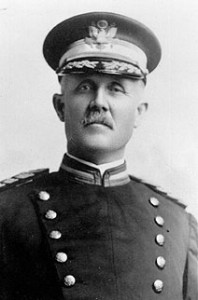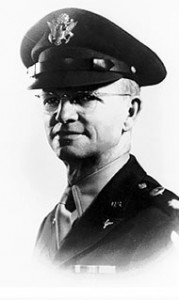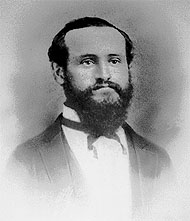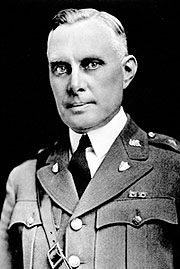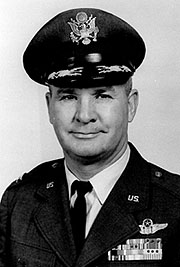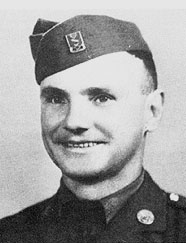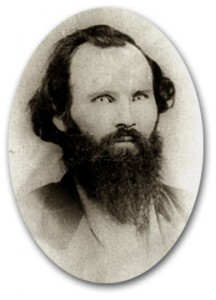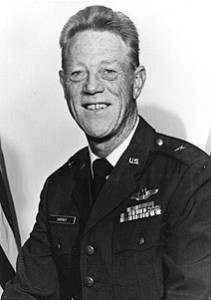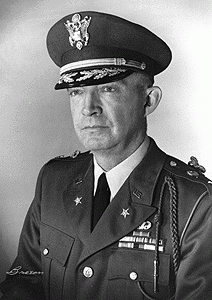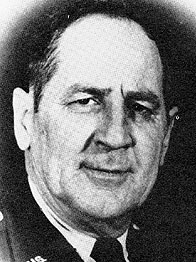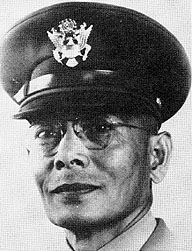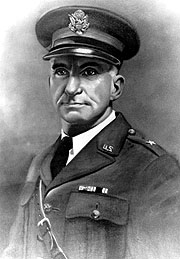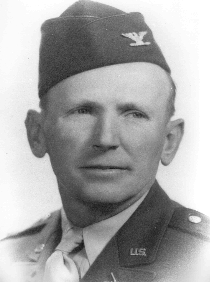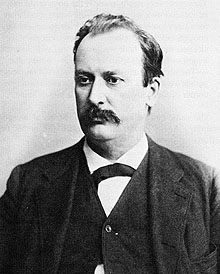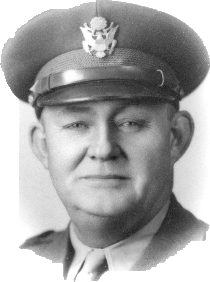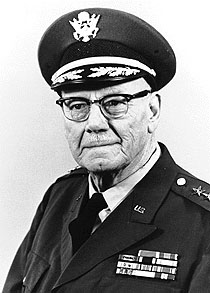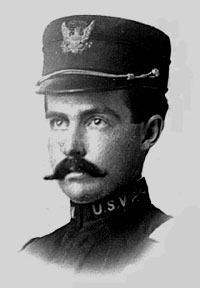By turning to the history of the 3d and 4th regiments, we find that they, with a few men from the Fifth, marched to Paola, Kansas, and under orders from the War Department, were consolidated, which formed the regiment bearing the number at the head to this history.
This regiment (the 10th) ought, in reality, to have been numbered the 3d was consolidated at Paola, April 3d, 1862. The regiment was about 800 strong, and from the fact that it was made up of men who had been in the service, and of organizations that had been culled out. It was perhaps composed of the best material, physically, of any regiment that ever went from Kansas. Very little sickness and only a few deaths from disease were shown on the rolls. Shortly after formation of the regiment it was marched to Fort Scott.
The first action noted is the attachment of four companies of the 10th being assigned to the 2d Ohio Cavalry. This expedition formed for the purpose of attacking a force under the notorious Col. Waitie, of the 1st Cherokee Rebel Regiment. The command was all cavalry and artillery. The men of the 10th were compelled to keep pace with the cavalry in the burning sun keeping 30 miles a day and marching 120 miles to be before the rebels camp ready and willing to attack the enemy. Another testament to the “true metal” of the 10th.
Marching from Fort Scott to the Osage Mission, and from the Mission to Humboldt, and then with 4 companies of the 9th, the Indian Regiments, and the 1st Kansas Battery marched to the Neosho River and thence to Baxter’s Springs. From Baxter’s Springs, now also with Solomon’s Brigade, marched to Cowskin Prairie. With the purpose of engaging the forces of Waitie, the advanced Brigade skirmished with the rebels. This failed to bring on a general engagement with the badly frightened rebels who fled in great confusion to the south.
After a couple of days they marched south with Weer’s Division in the direction of the rebel Clarkson’s camp, hoping to surprise that precious cut-throat and his ragamuffins. A detail was formed and marched all night arriving before the rebel camp about sunrise on the morning of July 3d, 1862.
The enemy was situated on a hill, the ascent being steep and rocky, and the only practicable road being a narrow track leading up on the south side. Weer, however, determined to throw his forces around the hill in order to capture the enemy if possible. The two companies of the 9th were moved to the northeast side, the 1st Indian Home Guard to the south and southeast, and the infantry of the 10th, supporting the 1st Kansas Battery, was ordered, after the artillery was found not to be of much service, owing to the abrupt rising of the ground, to fix bayonets and charge upon the enemy’s camp from the west. The attacking column coming from the west, the 9th and Indians being mounted, swept around on each side of the hill, driving the pickets, and then charged up the heights, while the command of the 10th, leaving a few Indians to support the artillery, charged up the western side of the heights, almost completely enveloping the enemy’s camp. Had it not been for the extremely rugged condition of the ground, and the density of the woods on two sides, the whole rebel command, amounting to about seven hundred, would have been captured. At the first dash, the enemy fired one round, and then broke in hopeless confusion over the two rough sides of the hill. Sixty or seventy of the rebels were killed or wounded, mostly killed, for the loyal Indians having but little quarter for their rebel brethren, and one hundred and fifty-five, including Col. Clarkson, their leader, taken prisoners, besides a large amount of camp and garrison equipage. The 10th’s loses were light with only a few men wounded.
The 10th then moved back to Wolf Creek where they rejoined their regiment. After a few days camp they marched with Weer’s division towards Fort Gibson, then held by the rebel Gen. Cooper with 5000 men. the command marched to Flat Rock Creek, eighteen miles from Gibson. Cooper retreated across the Arkansas River as the Division approached. The regiment kept falling back from camp to camp until it reached Ft. Scott, on the 15th day of August, where it remained.
On the 27th of August, 1862, the 10th forming part of the 2d Brigade, Frontier Division, marched into Missouri to assist in checking the advance of the rebel force then moving through the western part of that State, under Cols. Coffey and Cockrell. After traversing a good part of the western portion of that state, partly on foot, partly being jostled in 6 mule wagons the pursuit was abandoned. The rebel chieftains, after marching as far north as Lone Jack, retreated to the hills of southwestern Missouri and Arkansas. Here the rebels were reinforced. The 10th had to wait for the Division to concentrate, before giving battle to these great Missouri horse racers and horse thieves.
Soon after the celebrated chase the Division met the rebels who had come to bay after receiving heavy reinforcements, at Newtonia, Missouri. The 10th participated in the fight at this point, receiving, however, very little damage, though they stood under the fire of the enemies artillery for several hours, but their aim being bad and the distance great. Under the command of General Solomon and with is usual caution he refused to permit the line to advance. He was particularly severe on the 10th, threatening them with dire vengeance if they dared moved ahead of the battle line, which was a mile and a half away from the enemy. The regiment fell back to Sarcoxie, eighteen miles north, waiting for Gen. Blunt, who arrived and restored the confidence among the troops, and especially the 10th, they having great faith in his good sense and sagacity. The army with two additional divisions moved back to Newtonia where they quickly routed the enemy, driving him to the Arkansas line.
Soon after this the regiment marched on the road to Pea Ridge, Arkansas, at which point they arrived about the 12th of October, after having made several halts on the way. Arriving at Pea Ridge, they were allowed to rest for a short time. The cavalry determined that the enemy had divided their force part going toward Huntsville and Fayetteville, while the other portion about five thousand strong, had moved west it the direction of the Indian Territory. Those moving to the west Gen. Blunt followed with the 1st Division, which the 10th was a part, was cut loose from the main Army of the Frontier. Reaching Bentonville, Arkansas on the 20th of October the 10th found that the enemy had moved a short time ahead of their arrival. The 10th then marched all day the 21st and all night, only to be disappointed the next morning, when, arriving within six or seven miles for the battle ground, to hear the roar of the artillery, and we not on hand to take a part.
After remaining in the vicinity of Old Fort Wayne, Cherokee Nation, at which point the fight last spoken of took place, we marched to Camp Bowen, on the head waters of White River. During the time of the stay at this camp, Companies A and B were detached and ordered to take possession of some flouring mills in the vicinity of Fayetteville, which they did, driving the enemy therefrom, but were compelled to abandon their camp on the approach of a large body of the enemy’s cavalry, slipping through this lines in the darkness of the night and rejoining their regiment at Camp Babcock on the head waters of the Grand Saline, where it had already arrived on the 10th of November.
On the morning of the November 27th the regiment broke camp and marched with the 1st Division on Cane Hill, in Washington County, Arkansas, where eight thousand cavalry and eight pieces of artillery under the rebel General Marmaduke were encamped. This force was the advance of Hindman’s army. The men all knew full well that though their march had been but lightly contested through Southwest Missouri and Arkansas, that from that time forward they would have more to do than drive away pickets. So when they made this march the chances that their Thanksgiving dinner would be lead with sabers thrown in to aid in digestion. they marched all day and late into the night of the 27th; slept a few hours and resumed march on the morning of the 28th. When within two or three miles of Cane Hill, their ears were greeted with the sound of the guns of the 2d Indiana Battery. Pushing forward at the double quick, we arrived just in time to help drive the enemy from his position around the College, which he had stubbornly maintained against the cavalry and artillery; but when the long line of gleaming bayonets of the 10th, 11th, and 13th Kansas, and the 9th Wisconsin flashed upon his sight, and when the musket balls began to whistle about his ears, he quickly gave up the contest at that point and retreated down the road, hotly pursued by the 2d and 3d Brigades, the 10th leading, and being entitled to the road, followed close upon his heels, giving him no time to reform until he had passed through the town, which is a scattering village of two or three miles in extent. On the rising ground at the south end of the village the enemy again drew a line of battle, but the 2nd Brigade moved up the road, the 10th leading the advance, the solid ranks and determined tread of the infantry again frightened this chivalric cavalry, and they scampered off before the men could get even a single shot. Again the enemy retreated to the mountains, four miles south of the village, where he made a strong stand, holding the cavalry and artillery in check, but breaking on the first charge of the infantry. The enemy made two more stands, from which he was quickly driven, and then, being thoroughly discouraged, fell back over the Boston Mountains, and pursuing him until darkness put an end to the battle.
The regiment went into camp at Cane Hill, but was suffered to remain quiet only a short time. It soon became apparent that Gen. Hindman’s whole army was advancing. The cavalry were constantly skirmishing with the enemy’s advance, which moved up slowly, but with that steadiness and force which showed that there was something besides cavalry pushing the advance. On the morning of the 7th of December the 10th was ordered out on the Van Buren road to assist in checking the rebel advance and to support the 2d and 11th, then pressed by an overwhelming force of the enemy’s cavalry. Scarcely had the regiment gone into line of battle at the far end of the village of Cane Hill, and had just began to move to the support of the forces engaged, when the startling intelligence reached them that General Hind, with his whole force, with the exception of his cavalry at the mountain, by a night march, had passed up on the east, by what is known as the “Wire Road”, completely flanking the 1st Division, and sandwiching himself between this Division and the other two Divisions of the Army of the Frontier, rapidly marching to its support. A retrograde movement was immediately made, the 10th, with the 1st Division, marching back by way of Rhea’s Mills, taking a circuitous route, to reach General Herron’s command, (the 2d and 3d Divisions), he being hotly engaged. Hindman, after having placed his army in the direct road leading from Cane Hill to Herron’s command, turned upon the latter for the purpose of crushing him before the 1st Division could come up. To reach Herron’s command, the regiment had by the circuitous route indicated to march eighteen miles, which they made the most of the way on the double-quick. Guided by the roar of Herron’s artillery, they marched straight from Rhea’s Mills to the right of his line of battle, where they immediately became engaged, opening the battle so far as the 1st Division was concerned.
For the part the regiment took in this engagement, the following report of Major Williams, is here inserted and made part of this history:
Headquarters 10th Kansas Volunteer Infantry,
Rhea’s Mills, Washington Co., Ark., December 10, 1862.
Lieutenant–I have the honor to submit the following report of the part taken by the 10th Regiment Kansas Volunteers in the battle of Prairie Grove, Sunday the 7th instant:
The regiment entered the Grove on the enemy’s left, by order of Col. Wm. Weer, commanding the 2d Brigade, about 3 o’clock p.m. Upon entering the timber, which was very dense, I ordered Co. B, Capt. Quigg, to deploy as skirmishers to find the enemy. They had but just formed, and the skirmishers advanced thirty yards, before the enemy opened on us, and the regiment was engaged under a terrific fire, which lasted for half an hour, when, by order of General Blunt, I withdrew the regiment to the open ground adjoining the timber; but after a few moments respite, we moved again to the front, about thirty yards in advance of our former position, obliquing our line of battle to the right, as the rebels had moved a large force to their left, extending far beyond our right. Our line at this time was in a hollow or depression in the ground, and the command by lying down, escaped most of the leaden hail which was hurled at them, by more than three times their number, for one hour and a half, exposed to a deadly fire during that time from the front and both flanks. It seems almost a miracle that the command was not annihilated.
About sunset the rebels charged with two regiments upon and turned our right flank, and I ordered the regiment to retreat which they did in good style, to the open ground in our rear. In the meantime, the 1st Kansas Battery, Lieut. Tenny commanding, which was in our rear, opened upon the rebels obliquely across our right with canister, which checked the force of rebels extending beyond our right and send them in disorder to the brush. The 10th then formed on the right of the Battery, when the rebels commenced playing upon us with a battery of artillery which they had planted on their extreme right, but it was quickly silenced by a few well directed shots from Tenny’s 1st Kansas Battery. By this time, it being quite dark, both parties ceased firing, and the engagement was ended.
Lieut. Phillips, Regimental Adjutant, and all the officers of the line present, behaved with gallantry and attended to their duties with promptness and decision. The non-commissioned officers and privates, also, with a very few exceptions, behaved nobly, and obeyed every command promptly and with a coolness worthy of veterans.
The following is a list of the killed and wounded in the regiment during the action;
Company A–Captain Milhoan commanding–forty-one in action. Wounded: 1st Lieut. Stephen J. Willis, hip, severely; Corporal T. B. Davis, thigh, severely; Corporal Guy R. Butler, knee, slightly; Corporal W. A. Simmons, arm, slightly; Private James W. Talbott, face, slightly; Private David L. Bretsinger, face, slightly; Private E. C. Wager, face slightly.
Company B–Captain Quigg commanding–thirty-nine men in action. Killed: Private Joshua Taylor. Wounded: Private Andrew Frueling, severely; Private John Pfahl, knee, severely; Private Charles Pringle, shoulder, severely; Private John M. Knight, neck, slightly; Private Garrett A. Lenarts, breast, slightly; Private Wm. Walker, head, slightly; Private Geo. W. Childers, ankle, slightly; Private John Cook, leg severely; Musician Christopher Trew, side slightly.
Company C–Captain brooks commanding–thirty-eight men in action. Wounded: Private Christian Bahrain, head, severely; Private Samuel Strong, thigh, severely; Private John W. White, hip, slightly.
Company D–Captain Hills commanding–forty-four men in action. Wounded: Sergeant Elisha L. Main, face, slightly; Private Wm. Butner, lungs, mortally; Private Francis M. Canfield, neck and shoulder, severely; Private John W. Priddy, side, slightly.
Company E–Captain Broadhead commanding–fifty-three men in action. Killed: Private Chas. D. Rice. Wounded: 1st Lieut. David Schoen, arm, mortally; Sergeant John W. Flora, foot, severely; Sergeant E. E. Oakley, shoulder, severely; Corporal C. E. Hearkins, arm, severely; Corporal N. G. Barker, side, slightly; Private James Putnam, foot, slightly; Private W. Baldwin, arm, slightly; Private James Harden, shoulder, severely; Private W. B. McClure, both arms, severely; Private W. P. Ramsey, arm, severely; Private B. Yates, hand, slightly; Private J. Williams, head, slightly; Private D. H. Wheeler, wrist, severely.
Company F–1st Lieut. Cyrus Leland Jr., commanding–forty-seven men in action. Wounded: 1st Lieut. Cyrus Leland Jr., shoulder, slightly; 2d Lieut. John Bryan, side, slightly; Sergeant Edward Hoverson, leg, severely; Private E. J. B. Jones, arm severely; Private Thomas P. Case, arm, slightly; Private E. J. B. Jones, arm, severely; Private Thomas P. Case, arm, slightly; Private Wm C. Searcy, face, severely; Private John McTonny, arm, severely.
Company G–Captain Harvey commanding–thirty-four men in action. Wounded: Sergeant Gregor Wohlwend, shoulder, slightly; Corporal Solomon Hasting, side, severely; Corporal W. C. Harris, elbow, slightly; Private John W. Burris, breast, slightly; Private R. F. Young, leg, slightly.
Company H–Captain Blanton commanding–twenty-four men in action. Killed: Private John W. Beck. Wounded: Corporal C. G. Tait, arm, slightly; Private Judson Allen, shoulder, slightly; Private Thos. R. Buxton, thigh and leg, severely; Private Wm. J. Brooks, knee, slightly; Private Gordon Neeland, Hip, slightly; Private Wm. H. Patterson, neck, slightly.
Company K–Lieut. Sherrin commanding–forty-seven men in action. Killed: Private William C. Calvin; Private William C. Wilson. Wounded: Corporal Austin George, leg, severely; Private A. Hammon, face slightly; Private John D. McCollough, arm slightly; Private Elisha Perkins, hip, slightly; Private Stephen Parsons, arm, severely; Earnest Schuman, head, severely.
Company I was on detached service and not in the action.
Total engaged, 387. Killed, 6. Wounded, 67.
I have the honor to be, your most obedient servant,
(Signed) H. H. WILLIAMS
Major commanding 10th Kansas Volunteers.
Lieut. J. K. Hudson, A. A. A. General, 2d Brigade, 1st Division, Army of the Frontier.
Considering the numerical strength of the regiment, the loss in killed and wounded shows considerable–about twenty-three per cent.
This was the oldest regiment in the army, and of course was entitled to the post of danger; and it would seem that their selection proved sagacious in this respect, as the number of their casualties attest. The loss in killed on the field is not so great, but quite a number died afterwards of wounds received, among them Lieut. Schoen, who was one of the best officers in the regiment. Lieut. Schoen was a German. When he came to this country, like all intelligent men of his section, he espoused the cause of freedom, He was a good hater of the oligarchy of the South and their principles, and when the war broke out he was one of the first to offer his services to the country of his adoption. He, with the ten or twelve others, whose death can be traced to the bloody day of Prairie Grove, sleeps in his last resting place. The shrill notes of the bugle will no longer call them to duty. Their homes are in the narrow trench on the far-off rocky hills of Prairie Grove, but their memory, while it saddens, is still cherished by the recollection of their prowess on the battle field, and their sterling good qualities of citizenship. Rest in peace.
This battle of Prairie Grove was one of the hardest fought battles of the war, and when we consider the disparity in numbers, the Union army numbering only twelve thousand, while the enemy, according th Gen. Hindman’s report, was twenty-eight thousand strong, with thirty pieces of artillery; and considering that the enemy retreated during the night, leaving his dead and wounded on the field, showing his overwhelming defeat, speaks well for the courage and fighting qualities of the army. Conspicuous among these brave men and trained regiments was the 10th Kansas, and they will be pardoned, at least by soldiers, if they do, with a little honest pride, cite prominently to their friends in Kansas the part they performed in the battle of Prairie Grove, and the writer of this narrative will be pardoned if he has traveled out of the direct history of the regiment, for the only possible way to show the deeds of this organization is to explain the surrounding circumstances, which consists mostly in the movements of the Division and brigade of which it formed an integral part, and its history cannot be intelligently explained without this circumlocution.
After the battle of prairie Grove, which was fought on the 7th day of December, 1862, the regiment marched back to Cane Hill, where it went into camp and remained until the 27th of December. About this time the General commanding received news that Hindman had left a large portion of his army on the north side of the Arkansas River, at Van Buren, forty miles distant. The order was given to the 10th to march at daylight on the morning of the 27th. This was a very severe march, the infantry traveling twenty-five miles on the first day, wading Cove Creek some twenty or twenty-five times, some of the time the water striking them to the waist, and this, too, in mid-winter. The other infantry regiments lost quite a number of men from this terrible exposure, whilst the 10th lost none from its effects, proving what was claimed in the early part of this history, that they were men of the very best physical constitutions. On the 28th of December the regiment arrived before Van Buren, and supported the 1st Kansas Battery while it shelled the enemy from his covert on the bank of the river. This dash on Van Buren gave the finishing touch to Hindman’s army, he being driven across the river after an obstinate fight, with the loss of several killed and wounded, and three or four hundred prisoners captured.
On the 29th, the 10th fell back with the Army of the Frontier to Fayetteville. After remaining there a short time, they marched to Elm Springs, twelve miles north, again went into camp , with the prospect of remaining some time. This delusion, however, was quickly dispelled.
After the repulse of the rebels at Van Buren, Marmaduke, with about six thousand cavalry, crossed back over the Arkansas River at Spadra Bluffs, near Clarksville, and marched by way of Yellville, Arkansas, and Forsythe, Mo., to Springfield, Mo., and was well up to that town before Gen. Schofield (now the commander of the Frontier Army, and whose forces lay around Fayetteville and Huntsville) knew anything of the trick he was playing. There being but at small force at Springfield, General Schofield ordered a Brigade of Cavalry and the 10th Kansas to make a forced march to that point, to relieve the garrison and raise the siege. Amid blinding snow and hail they marched north towards the beleaguered town, making thirty-five miles a day, and actually breaking down the horses of a goodly number of the cavalry. On the approach of this force, Marmaduke raised the siege and struck off in an easterly direction. The Brigade of which the 10th formed a part followed and overtook the enemy at Sand Springs, thirty miles from Springfield, when they easily drove him, he in his hurry running right into the command of Gen. Warren, who hurled him back into Arkansas much more rapidly than he had advanced. Thus the 10th was among the last who assisted in driving this bold raider from the Union lines, and deserves credit for its extraordinary marching, which conduced to the hurling of the enemy against Gen.. Warren’s command, giving that officer the opportunity to give him the finishing stroke for that campaign. The 10th, after the routing of Marmaduke, marched back to Springfield, where they went into camp, and remained there until the 27th of February, 1863.
During the time of the stay of the regiment at Springfield, Capt. Blanton resigned, February 2d, 1863, and was then mustered into the Veteran Reserve Corps.
On the 15th of February, 1st Lieut. S. J. Stewart was promoted to Captain of Co. H vice Blanton, resigned; and at the same date 2d Lieut. Jas. H. Signor was promoted to 1st Lieut., vice Stewart, promoted.
On the 27th, we marched to a camp eight miles north of Mount Vernon, where we halted for quite a period.
On the 1st of March, 1863, 2d Lieut. William B. Kieth was promoted to 1st Lieut. Co. E vice Schoen, deceased. On the 4th of the same month, 1st Sergt. Levi Kittenhouse was promoted 2d Lieut. Co. H vice Signor promoted; and on the 10th, 1st Sergt. John E. Thorp was promoted to 2d Lieut. to fill a long standing vacancy.
We remained in camp at the last named place until the 15th of March, when we marched to the White river country to check the advance of the enemy’s cavalry, which had rallied under Gen. Shelby, and were advancing on Forsythe, a village in Taney county. On the approach of our forces, now under Col. Weer, the enemy fell back to his fastness in the White River hills, and the regiment was saved the necessity of following any further in that direction.
March 23d, 1863, Captain Greenville Watson, company K, resigned.
It having been found that the enemy were in check by a portion of the command, the 10th, along with two other Kansas regiments, was ordered to the vicinity of Fort Scott, that they might furlough a part of their men, giving them an opportunity to pay a short visit to their homes, and seek the rest they so much needed. So they marched to within a few miles of the Kansas line, where they went into camp about the 1st of April, and a portion of the men were went home for twenty days.
On the 3d of April, 1863, 1st Lieut. John Sherrin was promoted to 1st Lieutenant vice Loring, promoted. Also on the same day, Thos. McGannon was mustered as 2d Lieutenant Co. K vice Sherrin, promoted.
On the 21st of April, 1st Lieut., and Adjutant Jas. A. Phillips was mustered out to accept promotion in the 1st Regiment, India Brigade, and was mustered on the 10th of July, 1863, as Major of that regiment.
On the 23d of the same month, Sergeant Gregor Wohlwend was promoted to 2d Lieutenant vice Warner, resigned.
On the 27th of April the regiment marched to Rolla, arriving there in due time, and was for a time incorporated in the army under General Herron, which was made up of the old Army of the Frontier and several regiments from St. Louis.
On the 9th of May, Surgeon John W. Scott resigned. On the 29th of the same month, 1st Sergeant Solomon Smith, Co. E, was promoted to 2d Lieutenant vice Keith, promoted. On the same day, 2d Lieut. Thos. McGannon was promoted to 1st Lieut. and Adjutant of the regiment, and on the day following (the 3d) 1st Sergeant George W. May, same company, was promoted 2d Lieutenant vice McGannon, promoted.
The regiment, from the time of its arrival at Rolla until its departure, was detailed on Provost duty, Capt. Hill, Co. D. Provost Marshall of the town.
On the 4th of June, 1863, the regiment received orders to proceed to St. Louis, where it arrived., by rail, on the 8th of the same month. It was ordered east, to Indiana, to intercept the rebel Gen. Moorage; who was then making his celebrated raid on the north side of the Ohio. By the time of its arrival at Indianapolis, it was found that sufficient troops were in pursuit to deal with Moorage, provided they could come up with him. The regiment returned to St. Louis, where it arrived on the 18th day of July, 1863. During the time it was in Indiana, Co. I was detached, and doing duty as Provost guard at St. Louis. In the month of August, the regiment moved by Rail to Kansas City, where Co. I rejoined it.
During the time of the stay of the regiment at Kansas City, Co. K was detached in the month of September and sent to Topeka, Kansas, where it remained until November, when it marched to Fort Scott, Kansas.
On the 18th of September, J. Finn Hill, 1st Lieut. Co. I, was promoted to Major of the 14th Kansas Volunteer Cavalry.
In September, the regiment marched into the Sni Hills in pursuit of the guerrilla Quantrell and his band of cut throats. The pursuit, however, was unsuccessful, Quantrell and the main part of his command having, soon after his murderous raid on Lawrence, marched south into the Indian Territory and Texas, eluding the trap that was so well set by the 10th for him. The regiment remained on duty in and around Kansas City until January, 1864.
On the 10th of November, 1863, Wm. B. Stone, 2d Lieut. Co. A, was promoted to 1st Lieut. vice Willis, mustered out.
On the 1st day of January, 1864, the regiment marched for Warrensburg, Mo., from which place they took rail for St. Louis. Arriving at the last named place, they were ordered to Alton, Ill., to take charge of the military prison at that place.
There is not much to record of the regiment while it lay at Alton. One company was detailed to take charge of a number of prisoners and transfer them to Fort Lafayette. It was a regular and monotonous routine of duty, little calculated to satisfy the martial ardor of the men, nor was it conducive to their health, as the rosters at that place show. Here the small-pox, in its most severe form, attacked the regiment, and quite a number of the men died with the disease.
On the 10th of March, 1864, 2d Lieut. Gregor Wohlwend died with consumption.
May 5th, 1864, the regiment was ordered to St. Louis, and arrived the same day, when it was detailed as provost guard of the city.
On the 7th of June, 1864, Assistant Surgeon Henry H. Tuttle was promoted Surgeon vice Scott, resigned.
In the month of July, Col. Wm. Weer, was arrested and tried under various charges and specifications, and was finally dishonorably dismissed the service. It is due to the memory of Colonel Weer to say that the sentence of the court was, a year afterwards, set aside.
In the month of August, 1864, the regiment was ordered to Fort Leavenworth for the purpose of being mustered out of service, and after its arrival at that point was mustered out in the following order by 1st Lieut. J. R. Kemble, 3d U. S. Cavalry, mustering officer.
Field and staff, August 20, 1864. Lieut. Col. John T. Burris commanding.
Company A, August 19, 1864. Captain Thomas E, Milhoan commanding regiment.
Company C, August 20, 1864. 1st Lieut. James H. Harris commanding .
Company D, August 19, 1864. 2d Lieut. Levi Rittenhouse commanding.
Company E, August 18, 1864. Captain John F. Broadhead commanding.
Company F, August 19, 1864. Captain Nathan Price commanding.
Company G, August 19, 1864. Captain James M. Harvey commanding.
Company H, August 19, 1864. Captain Samuel J. Stewart commanding.
Company I, August 19, 1864. 1st. Lieut. Seth M. Tucker commanding.
Company K, August 19, 1864. Captain Horace G. Loring commanding.
Second Lieut. David Whittaker, at the time of the muster-out of his company was absent on detached service with an Examining Board at St. Louis which was convened per Special Orders, No. 358, from War Department, series of 1863, and was relieved from duty with the Board August 18, 1864, “his term of service having expired,” which is all that is on file in relation to his muster-out of service.
It will be seen that at the time of the muster-out of service at Fort Leavenworth, some of the companies were under the command of Lieutenants, and they from other companies. This is explained by the fact that the proper officers for the command of these companies, and other officers not mustered out at that time, were already incorporated and mustered into the veteran organization, consisting of four companies made up out of the 10th under the following order, to wit;
Headquarters Department of the Missouri,
St. Louis, Mo., August 15th, 1864.
[Special l Orders, No. 225.]
XIV. The reorganization of the veterans and recruits of the 10th Kansas Infantry, contemplated in Par. 3, Special Orders, No. 220, current series, from these Headquarters, having been perfected, the following announced as the new organization of the regiment:
The re-enlisted veterans of Cos. C, E, F. A and K, consolidated with the recruits of Co. F, will form Co. A, to be officered as follows:
Captain, Chas. S. Hills, Capt. Co. D.
1st Lieut., Cyrus Leland, Jr., 1st Lieut. Co. F.
2d Lieut., Robt. W. Wood, 2d Lieut. Co. D.
The re-enlisted veterans of Cos. A, B, G and I, consolidated with the recruits of Co. I, will form Co. B, to be officered as follows;
Captain, Wm. C. Jones, Capt. Co. I.
1st Lieut., John E. Thorp, 1st Lieut. Co. I.
2d Lieut., John Bryan, 2d Lieut. Co. F.
The recruits of Cos. A, B, C, D, G and K will form Co. C, to be officered as follows;
Captain, Geo. D. Brook, Capt. Co. C.
1st Lieut., Wm. B. Stone, 1st Lieut. Co. A.
2d Lieut., Geo. W. May, 2d Lieut Co. K.
The recruits of Companies E and H–forty-six men–will form Co. D, to be commanded by:
1st Lieut. F. A. Smalley, 1st Lieut. Co. D.
There being no assistant Surgeon with the regiment, Surgeon H. D. Tuttle is retained in the service and assigned to duty with the veteran regiment.
Major H. H. Williams, 10th Kansas Infantry, is assigned to the command of the regiment.
By command of Maj. Gen. Rosecrans.
(Signed) FRANK ENO, Assistant Adjutant General.
The 10th Kansas Veteran Infantry was organized from the veterans and recruits of the 10th Kansas Volunteer Infantry on the 15th day of August, 1864, pursuant to the above order, and composed of four companies, viz; New Co. A, new Co. B, new Co. C and new Co. D. The regiment was commanded by Major henry H. Williams from its organization until the last of August, 1864, when he was detached and placed on duty in charge of Schofield Barracks, St. Louis, transferring the command of the regiment to 1st Lieut. F. A. Smalley, Co. D.
October 20th, 1864, the regiment left St. Louis by rail, and arrived at Pilot Knob, Mo. Upon its arrival at the latter place–October 24, 1864,–Capt. George D. Brooke, Co. C, relieved Lieut. Smalley in command.
On the 2d day of November the regiment returned, striking the railroad above Franklin, and from there, by rail, to St. Louis, where they were assigned quarters at Benton Barracks and remained until November 7, 1864, when they embarked on a transport and proceeded down the Mississippi and up the Ohio, to Paducah, Ky., arriving there November 12, 1864. Here Captain Brooke was relieved in command by Captain William C. Jones, Co. B.
The regiment remained in camp until November 23d, when it re-embarked on transport and proceeded up the Cumberland river, arriving at Nashville, Tennessee, Nov. 28th, where it was immediately transferred to the cars and hurried off to Columbia, Tenn., at which place it arrived the next day, and was temporarily assigned to the 4th Army Corps, General Stanley commanding. On the 28th and 29th of the same month, it fell back before the advancing army of General Hood to Spring Hill, a distance of eleven miles.
Hood still kept advancing, steadily pushing back the Union forces, and it was evident that something must be done to check his advance, or he would soon be in possession of Nashville. On the 30th, the regiment fell back to Franklin, Tenn., and engaged in the battle at that point. It is to be regretted that no official report of the part taken by the 10th in this battle is where it can be obtained; enough, however, is known by the writer of this article, who has had frequent conversations with Capt. Jones, the commander of the regiment at the time, to know that it performed an honorable part, losing quite a number of men, which are not and cannot be accounted for in the schedule of the losses of regiments in the Adjutant General’s office.
December 1st the regiment fell back towards Nashville. On this retreat of General Schofield, the 10th Kansas was one of the regiments that covered the retreat, and were constantly skirmishing with Hood’s advance until we arrived in the vicinity of Nashville, where it commenced throwing up works for the defense of the city. On the 8th of December, the regiment was transferred to the 17th Army Corps, which was afterwards designated “Detachment Army of the Tennessee,” changed to the 16th Army Corps.
The regiment remained in the main works and rifle pits, engaged in continuous picket firing with the enemy until December 16th, when they were deployed in front of the main line as Brigade skirmishers in the eventful assault of that day, joining the assaulting column in time for the final charge that routed and nearly destroyed Hood’s veteran army.
The following is a report of the part taken by the regiment in the battle of Nashville:
Headquarters 10th Kansas Veteran Infantry,
2d Brig., 2d Div., Det. Army of the Tennessee,
December 20, 1864.
Lieutenant–I have the honor to report the part taken by the 10th Kansas Veteran Volunteer Infantry in the battle of Nashville, December 15th and 16th, 1864;
On the evening of the 14th instant, I received orders from Brigade headquarters to move the following morning, at 6 o’clock, with three days’ rations in haversacks and one blanket to the man. The command was immediately put in readiness to move in the compliance therewith. At few minutes after 6 o’clock on the morning of the 15th instant, I received orders from Lieut. W. G. Donnan, A.A.A.G., to move my command to the skirmish line, and relieve the three companies then on that duty. I at once moved to the front and relieved them as directed, placing thirty men on the right under Lieut. Geo. W. May, and fifty more of Co. B on the left, under command of Lieut. J. E. Thorpe, holding in reserve Co. A, numbering seventy-seven men, twenty of Co. B and eight of Co. C, all under the command of Captain Geo. D. Brooke. At 9 a.m., I received orders from Lieut. Eisenhart, A.D.C., to advance my line as soon as the skirmishers of the Brigade on my right came to the line. I ordered my line forward, moving to the front, without opposition, for about one hundred yards, when we came within range of the enemy’s skirmishers, which, for a moment, checked the advance of my line, but soon the men found shelter behind fences and logs and quickly dislodged the enemy’s skirmishers from their entrenched position. My line then advanced, driving them back to their reserve, and to within four hundred yards of their main works, where we were again checked. I accordingly ordered the line re-enforced by thirty men, under command of Lieut. John Bryan, which being thus strengthened advanced, diving the rebel skirmishers into their line of entrenchments, which being reached, his main line opened with canister, grape and musketry upon us. I then ordered the line re-enforced by seventy-five men of Co. A, under command of Lieut. R. W. Wood. As soon as the line was strengthened, the men found shelter behind trees and stumps, about two hundred yards from the enemy’s line of works, so that they had perfect range upon that portion of his works in my front, completely silencing his battery which had given me so much trouble. I held this position until 4 p.m., when the main line came up. I then drew off my skirmishers and joined my Brigade, which I found about three-fourths of a mile to my left. My loss was nineteen wounded.
Surgeon H. D. Tuttle was ordered by the Brigade Surgeon, in the morning, to go to the front with a train of ambulances.
On the morning of the 16th, I was ordered by Lieut. Wm. G. Donning, A.A.A.G., to form my command fifty paces in rear of the Brigade. When the advance was ordered, I moved the 10th Kansas in obedience to the above instructions, until the Brigade was halted under the shelter of a hill from the enemy’ artillery. I then moved my command to within ten yards of the rear of the brigade, where we lay under fire of the enemy’s guns until 4 o’clock, when the charge was ordered, when the men sprang to their feet and advanced on a double-quick, until the enemy’s parapets were scaled, following the routed foe to the foot of the mountains, about three-fourths of a mile in rear of his works. My loss was five men wounded.
Lieut. F. A. Smalley deserves great credit for his services and encouragement to the men.
Respectfully, your obedient servant,
(Signed) W. C. JONES, Captain Comd’g Regt.
Lieut. W. G. Donnon, A.A.A.G., 2d Brig., 2d Div., 16th A. C.
Official: John E. Thorpe, Lieut. and Act’g Adjutant.
It will be seen by this report that the utmost faith was placed in this little handful of veterans, giving them the skirmish line to bring on the battle in front of the 2d Brigade.
On the day following the battle (the 17th) the regiment engaged in the charge that completely scattered the remnant of the enemy, and sent him in the utmost confusion towards the Tennessee River, following his Cavalry and infantry stragglers as fast as the conditions of the roads would permit. The regiment reached Rutherford, Tenn., December 21st.
Capt. Chas. S. Hills, Co. D, having been relieved from duty in St. Louis, Mo., reached and assumed command of the regiment on the 21st. On the following day the regiment moved to Columbia, Tenn., thence to Linneville, and thence to Pulaski, same State, reaching the latter place Dec. 27th, 1864.
On the 29th Day of December, the resignation of 1st Lieut. Cyrus Leland, Jr., Co. A, was accepted, per Special Orders, No. 360, from Headquarters Department of the Missouri, series of 1864.
At Pulaski the regiment left the main road and marched in a southwesterly direction., passing through Lawrenceburg, Warrensburg and Glendale, the command arriving at Clifton, on the Tennessee River–a distance from Nashville of one hundred and twenty miles–on the 2d of January, 1865.
The march from Nashville to Clifton was one of the most severe of the war. The roads were in the worst possible condition, and not a day passed without heavy drenching rains, sleet or show. Every tent, blanket and many of the great coats of the men were left in the ditches at Nashville. One-half of the command had worn out their shoes, and were compelled to march the last sixty miles literally barefooted, two days of the march the snow and sharp sleet being six inches deep. Yet not a man murmured during the entire march, and more strange still, none were sick.
January 3d, the regiment remained in camp. On the next day (the 4th) it embarked on transports and proceeded up the Tennessee River to Eastport, Miss., which place was reached January 7th, where it went into camp. On the 9th of January, the regiment made a reconnaissance to Iuka, Miss., a distance of 10 miles, skirmishing with Forest’s cavalry the greater portion of the way, and returned to camp the same day.
January 20th, 1865, 1st Lieut. Fred. A. Smalley, new Co. D, was mustered out of service by reason of having served three years.
On the 22d of January, the regiment crossed the river at Cumberland and marched to Waterloo, Ala., a distance of six miles, where it remained on outpost duty until February 8th.
On the 25th of January, 1865, 2d Lieut. Robert W. Wood, new Co. A, was mustered as 1st Lieut., to fill the vacancy occasioned by the resignation of Leland.
On the 8th of February, the regiment embarked on the steamer Tarascon and proceeded with the fleet to Paducah, Ky., thence to Cairo, Ill., where it arrived February 10th, and thence to Vicksburg, Miss., reaching the latter place February 14th. Here it disembarked and went into camp in rear of the city, where it remained until February 19th. It then re-embarked and proceeded down the river, passing Natchez on the 20th and arriving at New Orleans, La., February 21st, going into camp at Chalmette, six miles below the city, where they remained until March 7th, 1865.
In the meantime, Maj. H. H. Williams, on or about the 23d day of February, 1865, was mustered out per Special Orders, No.–, series of 1865, Headquarters Department of the Missouri, he having been on detached service in that Department from the time he was relieved from duty with the 10th–August 16th, 1864.
On the 1st day of March, 1865, Capt. Chas. S. Hills, new Co. A, was mustered as Lieut. Colonel vice Williams, mustered out.
About the time that Maj. Williams was mustered out, forty-seven drafted men and substitutes were assigned to Co. D, filling it to the dimensions of a company, which entitled the Battalion to a Lieutenant Colonel, and gave Capt. Hills the position.
Soon after Hills’ promotion, 1st Lieut. Robert W. Wood was mustered in as Captain of Co. A vice Hills, promoted, and 1st Sergeant Porter M. Phillips was mustered as 1st Lieutenant of Co. A vice Wood, promoted.
On the 7th, the command embarked on the steamer Empire City, passed down the river to the Gulf, and arrived at Fort Gaines, Ala., on the 8th of March. Here the regiment disembarked and went into camp on Dauphine Island, where it remained until March 19th, when it embarked on the gunboat Nianza, No. 42, and remained on board, anchored in Mobile Bay, until the morning of the 20th, when it joined the Corps fleet and proceeded up the Bay to the mouth of Fish River, and up that stream to Donnelly’s Mills, a distance of forty-five miles from Fort Morgan. Here the regiment went into camp and threw up a line of earthworks, where it remained awaiting the arrival of the 13th Army Corps until March 25th, when they struck camp and marched seven miles through the swamps. On the 26th of March, the regiment was deployed as skirmishers in front of the entire army, and drove the enemy’s outpost of six hundred cavalry eleven miles into their main works at Spanish Fort, with a loss of only two men wounded. March 27th, the 2d Division, including this regiment, was thrown around in the direction of Fort Blakely, and eight miles from that place, where the Division threw up strong earthworks and remained holding that point.
April 1st, 1865, 2d Lieut. Geo. W. May, Co. C, was transferred to Co. D vice Smalley, mustered out.
On the 2d day of April, 1865, the regiment was again deployed as skirmishers in front of the Division, and skirmished eight miles through swamps to the right of Fort Blakely, and formed a junction with Gen. Steele, then marching in from Pensacola, Fla. On the 3d day of April, we invested Fort Blakely, threw up works, and commenced the siege, which continued with constant firing until April 9th, when the regiment was deployed from the rifle pits as skirmishers in front of the entire Brigade, who charged from the main works, and unaided by the main line, captured the entire line of the enemy’s works in front of the Brigade.
The following is the official report of the part taken by the 10th Kansas Veteran Volunteer Infantry in the action at Fort Blakely, Alabama:
Headq’rs Batt. 10th Kan. Vet. Vol. Infantry,
Fort Blakely, Ala., April 11, 1865.
Adjutant General of the State of Kansas:
Sir–I have the honor to make the following report of the part in which the troops under my command participated in the assault on the enemy’s works in rear of Fort Blakely, Ala.:
At 10 o’clock, a.m., on the 9th of April 1865, I received orders from Brig. Gen. Gilbert, commanding Brigade, to hold my regiment in readiness to move at a moment’s notice, which order was at once transmitted to Co. commanders. At 1 o’clock p.m. I received orders to move immediately to the outer line of works and relieve the picket then occupying them. a detail of fifty men under Lieut. Bryan were then already on the reserve skirmish line, and twenty-five men of the command were absent from camp with a working party. At 2 p.m. I occupied the outer picket line, relieving the old picket, and at 3 p.m. Lieut. Bryan reported to me with the picket reserve of fifty men. At 3:30 p.m., I was further strengthened by twenty-eight men, under 2d Lieut. U. S. Sims, Co. B, 27th Iowa, which completed the skirmish line in front of the entire Brigade, consisting of one hundred and forth-eight men, in the following order: Right wing, detachment Co. B, 27th Iowa and Co. B, 10th Kansas, under Capt. W. C. Jones of the latter, with Lieuts. U. S. Sims, 27th Iowa, and John Bryan, 10th Kansas, subordinate. Left wing, Cos. C and D, 10th Kansas, under Capt. Geo. D. Brooke, with Lieut. George W, May, subordinate. Center, Co. D, 10th Kansas, under Capt. R. Wood, with Lieut. P. M. Phillips, subordinate.
At 4 p.m., Gen. Gilbert notified me that the advance on the rebel works would be made at 5 o’clock, commencing on the left and continuing through the line, each man following the one on his left, my left immediately following the right of the 3d Brigade skirmishers; that I should advance my line with my right retired and drive the enemy’s pickets from their pits, draw the fire of his main line, and ascertain his strength as well as his weak point, and in the event that he should open on the line with spirit and expose it to too hot a fire, I should take advantage of whatever cover the fallen timber and irregular ground offered, and lie down and await the arrival of the main line.
At 5:30 p.m. the movement commenced as directed. The men leaping over our entrenchments, advanced on a run to the enemy’s first line of rifle pits, where were abandoned without much resistance, as also was the second line. While descending the slope to the ravine which lay in my front, the enemy opened with a galling fire of artillery and musketry, using shell, spherical case, canister and grape, with induced me to look for shelter in the ravine, in accordance with previous instructions, but which, on reaching, I found to enfiladed, and affording no shelter whatever. For this reason no halt was ordered, our safety depending on breaking through the main works on my left, if possible; if not, then at any point, take him on the flank and double him up. On gaining the high ground beyond the ravine, the firing became more rapid, and had it been well directed, would have been very destructive. No one in the line returned the fire, but each devoted his whole energy to reach the works as soon as possible. Climbing over fallen trees with scare an effort, they cleared each line of abattis at a single leap, and scarcely noticing the ditch, mounted the parapets or poured through the embrasures at the recoil of the guns, which their last discharge had opened for them, and their line was broken. Turning the left of my line (which, after entering the Fort, had become a column) to the right, and being joined by those who had climbed the parapets, it swept down on their flank with fixed bayonets with scarcely any opposition, the men throwing down their guns and surrendering, and officers waving white handkerchiefs and delivering up their swords. Here, for the first time, I discovered that the left of the skirmishers of the Division of the 13th Corps did not connect with my right, but had made an interval of some eighty yards, and having a greater distance to pass over than my line, had not yet reached the works. Fearing that the enemy’s line in their front, with those who had escaped from my column, might discover our weakness and give us trouble if allowed to concentrate, I pushed on down the line so that he might not have time to recover from his panic, when I found that my right had already captured the men and guns at the center fort and the infantry support on the right, most of the left having been down the ravine to the rear, for the time escaped capture. A portion of the 13th Corps having now arrived, and all resistance being at an end and prisoners secure, I halted my command, reformed it, and rested the men until I received orders to join the Brigade. The distance from my right, where it left the picket line, to where it struck the enemy’s works, was five hundred and fifty yards, and the length of works captured five hundred and sixty yards. I am unable to give the exact number or rank of the prisoners captured by my command, as the success of the assault depended upon its being rapidly followed up after the line was broken, and leaving the prisoners and other trophies in other hands, which was done. I cannot, however, do justice to my command in fixing the number of prisoners captured by them at less than eight hundred, being one entire Brigade and two batteries, eight hundred stand of small arms and accouterments, and nine pieces of artillery, as follows; one 30 pdr. Parrott gun, carriage and limber with chest; two 7 inch siege guns with carriages, and 6 field pieces with limbers.
Below I give a list of casualties in the 10th Kansas Veteran Volunteer Infantry:
Company A. Killed: Sergeant George Dalton; Corporal John Buxton; private Andrew Wilton; private William Agnew. Wounded: Private B. F. Reed, severely; private W. R. Dykes, slightly; private S. Fraut, slightly.
Company B. Killed: Corporal John W. Thompson; private William Priddy. Wounded: Lieut. John Bryan, thigh, severely; private Simpson B. Plummer, severely; private Moses Manser, shoulder, severely; private John Jellison, left arm,, slightly.
Company C. Wounded: Private Louis L. Lyle, thigh, severely; private Henry B. Newsom, hand, severely; private Robert Carter, right side, severely; private Isaac Nimmo, ankle, slightly; total casualties in the regiment, 17.
Twenty-seventh Iowa Infantry. Wounded: Sergeant J. Jackson, face and right shoulder, severely.
The conduct of both officers and men during the assault and after the works were carried. was most exceptionable, all seemed to know what was to be done, and vied with each other in doing it first. Not a man faltered or deemed himself incompetent to accomplish the task.
To Lieut. John E. Thorpe, Acting Adjutant 10th Kansas Veteran Volunteers, I am indebted for the general direction of the colors. and his efficient services in conveying orders under the most difficult circumstances. Of each officer whose name appears above I wish to make special mention for the cool and systematic manner with which they executed my orders and handled their men; to them I am greatly indebted. To each soldier I owe much for the success of the assault, and did space permit, would mention each by name. Each officer is specially recommended for promotion.
Respectfully, your most obd’t serv’t,
CHARLES S HILLS, Lieut. Col. Comd’g Reg’t.
It is due to this regiment that the following extract from the report of General Gilbert, the commander of the Brigade in which it served at the battle of Fort Blakely, be inserted in this history:
“. . . . The 10th Kansas, a little band of heroes, rushed forward as into the jaws of death, with a determination to conquer or die. . . . .Too much praise cannot be bestowed upon them. I am at a loss or words to express my admiration of them and their gallant officers, and when I say that Lieut. Colonel Hills is worthy to command such men, language is exhausted in his praise.”
Such are some of the testimonials from brave and gallant officers under whom the 10th served. its conduct could not but call out the praise of the gallant Gilbert. The fact is, that this regiment actually captured Fort Blakely, taking four times their number prisoners, and capturing nine pieces of artillery. Such heroism, crowned with such results, is of rare occurrence, and it is doubtful whether the annals of the late war will show an act equal to it. Alone in the great army around Mobile, not another regiment from their own home (Kansas), to assist them in maintaining the fair name of their state, it devolved on the little band of the 10th veterans to see that the name of the Kansas soldiery was not tarnished by their neglect, and to extort their individuality, so to speak, from that strange army. This they did; being, after the battle of Blakely, the favorite regiment of their Corps.
The regiment remained in the captured fort until April 13th, when the Corps, including the 10th, marched to Montgomery, Ala., via Greenville, a distance of one hundred and sixty miles, reaching Montgomery April 25th, where the regiment remained, performing duty as provost guard at Corps Headquarters, and garrison at the post of Greenville, Ala., in the District of Montgomery, with headquarters at the latter place until August, ’65.
In the mean time, 2d Lieut. John Bryan died, May 14th, ’65, at New Orleans, La., of wounds received at Fort Blakely, Ala., April 9th, ’65, and 1st Sergeant Wm. M. Wicks was mustered as 2d Lieut. shortly afterwards vice Bryan, deceased. June 16th, ’65, Capt. Geo. D. Brooke, Co. C,. was mustered out of service by reason of expiration of term of service. July 1st, ’65, 1st Sergeant Henry Banblets was mustered as 2d Lieut., to fill the vacancy occasioned by the promotion of Wood.
On the 30th of August, ’65, all armed resistance to the Government of the United States having ceased, the Corps to which the regiment belonged was discontinued, and many of the troops, including the three years’ men, not veterans, were mustered out, while the remainder, including the 10th Kansas Veterans, were distributed though the southern and central portions of Alabama, as garrisons to the cities and towns, and affording protection, in the absence of civil law, to all classes, and assisting the agents of the Treasury Department in securing to the Government all property which fell into its hands by the surrender of the rebel armies. The regiment was engaged in this duty until August 30th, when the Government having declared by orders from the War Department that their services were no longer required, they were mustered out of the service at Montgomery, Ala., and ordered to proceed to Fort Leavenworth and there report to the chief mustering officer of the state for final payment and discharge. In compliance with this order, the regiment started, “homeward bound,” September 2d, 1865, and arrived at Fort Leavenworth, Kansas, on the 13th of the same month, where it remained until September 20th, 1865, when it was discharged and payment received.
From the organization of this veteran regiment to the date of its leaving the service, officers and men throughout performed their various duties well and faithfully, whether in camp, on the long and tiresome march, in the skirmish, or on the battle field. Too much praise cannot be bestowed upon them for the true patriotism, fidelity and gallantry which they displayed on all occasions.
In writing this history, the promotion of enlisted men, except in their own regiment, and their history, has not nor cannot be written without making the narrative too lengthy. Not but what they are entitled to the same consideration as the officers, but for reason of the possibility, as before mentioned, of running this document to too great a length.
A more brave, patriotic and intelligent set of men were never mustered into the Unites States service–a better record was never made by the men of any regiment. From the time of their first fight at Big Dry Wood until, with gleaming bayonets, they scaled the rough parapets at Fort Blakely, no act of cowardice or lack of patriotism tarnished their fair name.
Their dead sleep on the wooded hills of Prairie Grove, on the plains around Nashville, and in the morasses of Mobile–their maimed and wounded are in all our villages, but the memory of heroic deeds and lofty fidelity to principle still lives in the hearts of a grateful people, and the records of the office of the Adjutant General will hand down to a just and appreciative posterity their history without spot or blemish.
(Source: Report of the Adjutant General of the State of Kansas, 1861-’65. Reprint Edition. Topeka, Kansas: Kansas State Printing Plant (1896), pp. 177-197. Transcription courtesy of Dale Vaughn, Civil War Round Table of Eastern Kansas)

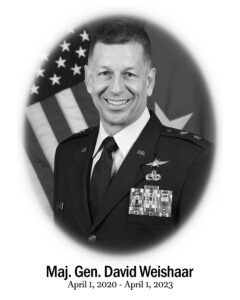 Maj Gen David Weishaar
Maj Gen David Weishaar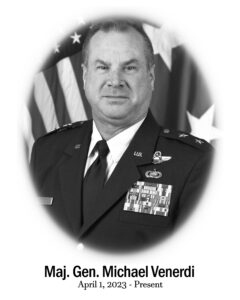
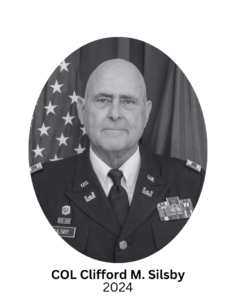
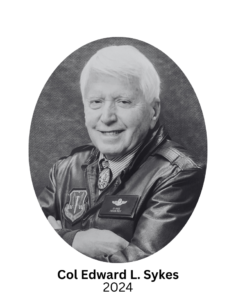
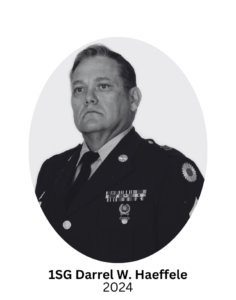 First Sergeant Darrel W. Haeffele was born on September 25, 1940, in Falls City, Nebraska. He graduated from Atchison High School in 1958. He attended Concordia College in Seward, NE for two years before starting a career in retail.
First Sergeant Darrel W. Haeffele was born on September 25, 1940, in Falls City, Nebraska. He graduated from Atchison High School in 1958. He attended Concordia College in Seward, NE for two years before starting a career in retail.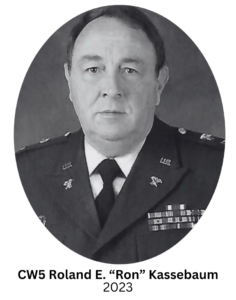 CW5 Roland E. “Ron” Kassebaum was born on February 21, 1946 in Deshler, Nebraska. He graduated from Hebron High School, Hebron, Nebraska in 1964. He attended Fairbury Junior College, Fairbury, Nebraska and the University of Nebraska, Lincoln, Nebraska, and received a Bachelor of Science Degree from the University of the State of New York in 1991. He later attended Liberty University, Lynchberg, Virginia, for courses in accounting and Allen County Community College, Iola, Kansas, for a course in Business Law.
CW5 Roland E. “Ron” Kassebaum was born on February 21, 1946 in Deshler, Nebraska. He graduated from Hebron High School, Hebron, Nebraska in 1964. He attended Fairbury Junior College, Fairbury, Nebraska and the University of Nebraska, Lincoln, Nebraska, and received a Bachelor of Science Degree from the University of the State of New York in 1991. He later attended Liberty University, Lynchberg, Virginia, for courses in accounting and Allen County Community College, Iola, Kansas, for a course in Business Law.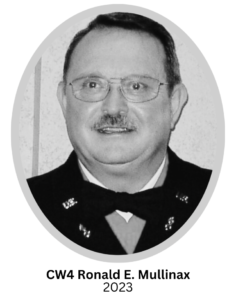 Chief Warrant Officer Four Ronald E. Mullinax was born on August 25, 1946, in Norton, Kansas to Earl and Mary Posson. He was adopted by John and Ada Mullinax. He grew up in Lenora, Kansas, graduating from Lenora Rural High School in 1965. After completing a Denver Automotive Institute training program, Ron worked at Look Body Shop in Norton until 1968.
Chief Warrant Officer Four Ronald E. Mullinax was born on August 25, 1946, in Norton, Kansas to Earl and Mary Posson. He was adopted by John and Ada Mullinax. He grew up in Lenora, Kansas, graduating from Lenora Rural High School in 1965. After completing a Denver Automotive Institute training program, Ron worked at Look Body Shop in Norton until 1968.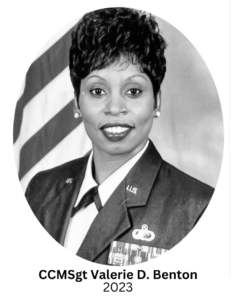 CCMSgt Valerie D. Benton was born on Dec. 10, 1959 in Racine, Wisconsin, where she spent her childhood. She graduated from Washington Park High School in 1978. Soon after graduation she enlisted in the U. S. Air Force and headed to Basic Training at Lackland AFB, Texas in December of 1978. After completion of Basic training, she attended Technical Training at Lowry AFB, Colorado, and graduated as a Food Service Specialist.
CCMSgt Valerie D. Benton was born on Dec. 10, 1959 in Racine, Wisconsin, where she spent her childhood. She graduated from Washington Park High School in 1978. Soon after graduation she enlisted in the U. S. Air Force and headed to Basic Training at Lackland AFB, Texas in December of 1978. After completion of Basic training, she attended Technical Training at Lowry AFB, Colorado, and graduated as a Food Service Specialist.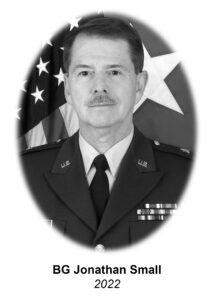 Brigadier General Jonathan P. Small served as The Adjutant General of Kansas from November 1, 2003 to January 4, 2004, culminating a 35-year military career as a distinguished attorney, community leader, citizen-soldier, and military leader. He served as Assistant Adjutant General-Army from 1999 to 2003, and as Commander of the Land Component for the Joint Force Headquarters-Kansas.
Brigadier General Jonathan P. Small served as The Adjutant General of Kansas from November 1, 2003 to January 4, 2004, culminating a 35-year military career as a distinguished attorney, community leader, citizen-soldier, and military leader. He served as Assistant Adjutant General-Army from 1999 to 2003, and as Commander of the Land Component for the Joint Force Headquarters-Kansas. General James H. Lane was a militia leader during the Bleeding Kansas period, the commander of the Kansas “Jayhawker” Brigade during the Civil War, and was one of the first United States Senators from Kansas.
General James H. Lane was a militia leader during the Bleeding Kansas period, the commander of the Kansas “Jayhawker” Brigade during the Civil War, and was one of the first United States Senators from Kansas.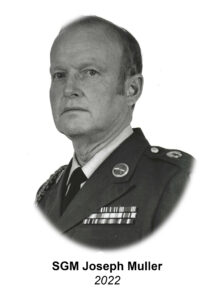 Sergeant Major Joseph T. “Jody” Muller was selected for the Kansas National Guard Hall of Fame for his exceptional service as a citizen soldier in the Kansas National Guard for over 41 years.
Sergeant Major Joseph T. “Jody” Muller was selected for the Kansas National Guard Hall of Fame for his exceptional service as a citizen soldier in the Kansas National Guard for over 41 years.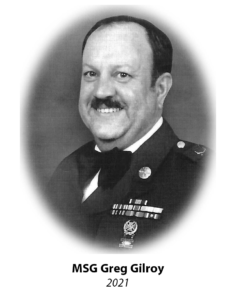 Master Sergeant Greg Gilroy was born on July 25, 1947 at Ottawa, Kansas. He was a lifelong resident of Ottawa, graduating from Ottawa High School in 1965. He then attended Emporia State University during the 1965-66 school year.
Master Sergeant Greg Gilroy was born on July 25, 1947 at Ottawa, Kansas. He was a lifelong resident of Ottawa, graduating from Ottawa High School in 1965. He then attended Emporia State University during the 1965-66 school year.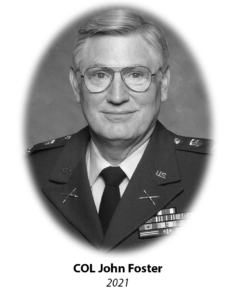
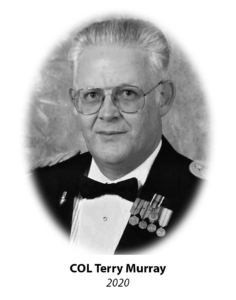
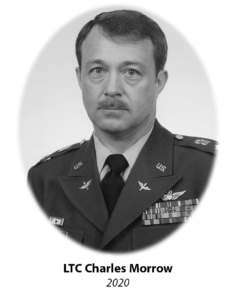

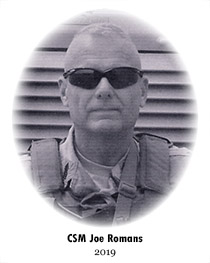
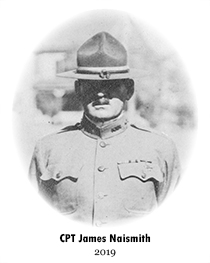

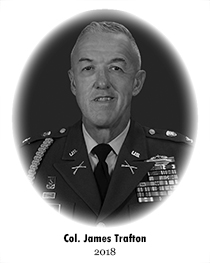
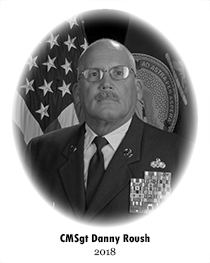
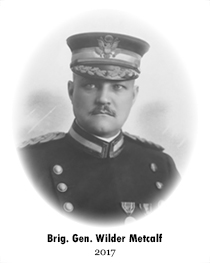
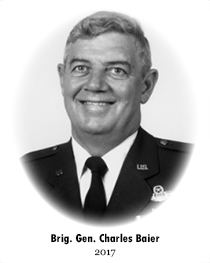
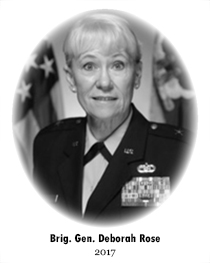 Brigadier General Deborah Rose entered military service with a direct commission into the United States Air Force Nurse Corps in March 1983, assigned to the 184th Tactical Fighter Group. She transferred to the 190th Clinic in December 1985. In October 1990, she deployed to Jeddah, Saudi Arabia, where she served in an Air Transportable Hospital during Desert Shield. In February 1991, she was activated and deployed to Offutt AFB, Nebraska, assigned to the hospital.
Brigadier General Deborah Rose entered military service with a direct commission into the United States Air Force Nurse Corps in March 1983, assigned to the 184th Tactical Fighter Group. She transferred to the 190th Clinic in December 1985. In October 1990, she deployed to Jeddah, Saudi Arabia, where she served in an Air Transportable Hospital during Desert Shield. In February 1991, she was activated and deployed to Offutt AFB, Nebraska, assigned to the hospital.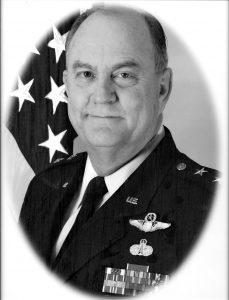
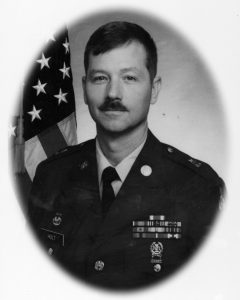 Sergeant Major Lynn E. Holt built his distinguished Kansas Army National Guard career developing strength, retaining Soldiers and insuring Soldiers received proper training. He served from the Detachment through State level. He is known for his ability to recognize Soldier needs at all levels. The same care he felt for Soldiers carried over into his community activities. SGM Holt’s passion for people and their needs exemplifies his true character. He devoted his entire adult life to the betterment of our nation, our state and the Kansas National Guard.
Sergeant Major Lynn E. Holt built his distinguished Kansas Army National Guard career developing strength, retaining Soldiers and insuring Soldiers received proper training. He served from the Detachment through State level. He is known for his ability to recognize Soldier needs at all levels. The same care he felt for Soldiers carried over into his community activities. SGM Holt’s passion for people and their needs exemplifies his true character. He devoted his entire adult life to the betterment of our nation, our state and the Kansas National Guard.